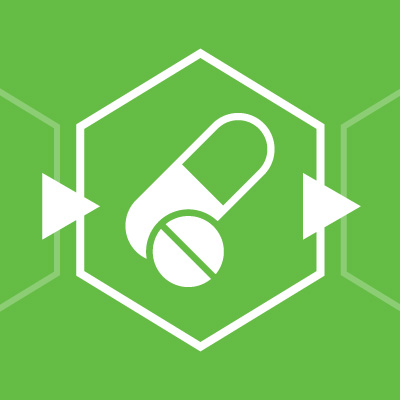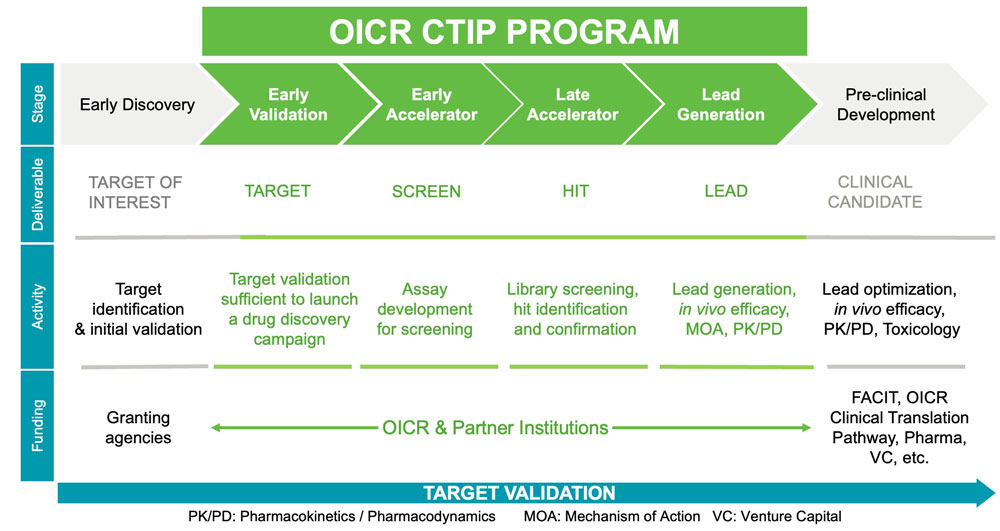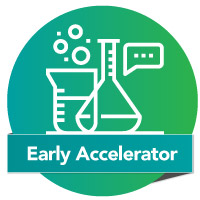
Cancer Therapeutics Innovation Pipeline (CTIP) supports the local translation of Ontario discoveries into therapies with the potential for improving the lives of cancer patients while creating a pipeline of promising drugs to attract partnerships and investment to Ontario.

Figure 1: The Cancer Therapeutics Innovation Pipeline: Stages, deliverables, major activities, and funding sources.
CTIP funds projects in four stages of preclinical drug discovery as shown in Figure 1:
- Early Validation (EV) projects: Deliver robust translational evidence that a Target-of-Interest (TOI) is associated with a specific cancer type(s) based on data from knowledge bases and from studies demonstrating that perturbation of the TOI in relevant cell-based models produces anti-cancer effects sufficient to trigger a drug discovery campaign.
- Early Accelerator (EA) projects: Deliver a validated primary assay to enable initial screening of molecules against a defined target. Preliminary evidence of linearity of results between the primary assay and supporting secondary assays under development is also required. At the end of the EA stage, teams must demonstrate the capability and capacity to scale up production of reagents, recombinant proteins, and/or cell systems needed to support the medium-high throughput screening campaigns of the Late Accelerator stage.
- Late Accelerator (LA) projects: Focus on screening, using validated primary, secondary, and orthogonal assays and deliver confirmed Hit molecules against a defined target supported by evidence of disease association. A confirmed Hit molecule should possess features that support its potential to become a Lead molecule.
- Lead Generation (LG) projects: Deliver high-quality Lead molecules (small or large), with demonstrated in vivo efficacy, ideally accompanied by pharmacodynamic and/or efficacy biomarkers, and markers of resistance (where applicable), that correlate with target modulation. Lead molecule profiles should be sufficiently mature to attract partnership/investment for further development and ultimately commercialization. In addition, a clear path for development of defined biomarkers to guide patient selection is required together with a Target Product Profile.

Cynthia Hawkins, The Hospital for Sick Children

killer engager for use in multiple myeloma
Alissa Visram, The Ottawa Hospital
Scott McComb, National Research Council of Canada

for combination with immune checkpoint inhibitors
Saman Maleki, Lawson Health Research Institute and London Health Sciences Centre
Masoud Vedadi, OICR
Rima Al-awar, OICR

Rima Al-awar, OICR
Methvin Isaac, OICR, David Uehling, OICR, Richard Marcellus, OICR

Rima Al-awar, OICR
Jonathan Bramson, McMaster University
Methvin Isaac, OICR; Gil Prive, Princess Margaret Cancer Centre; Richard Marcellus, OICR

Anne Petitjean, Queen’s University
Lois Mulligan, Queen’s University

Lisa Porter, University of Windsor
John Trant, University of Windsor

Liliana Attisano, University of Toronto
Rima Al-awar, OICR
Frank Sicheri, Sinai Health System, Jeff Wrana, Sinai Health System; David Uehling, OICR; Richard Marcellus, OICR; Methvin Isaac, OICR

Robert Rottapel, Princess Margaret Cancer Centre
Rima Al-awar, OICR
David Uehling, OICR; Richard Marcellus, OICR; Methvin Isaac, OICR; Ahmed Aman, OICR

Peter Greer, Queen’s University
Abdi Ghaffari, Queen’s University; Victoria Hoskin, Queen’s University; Sonal Varma, Queen’s University; Gena Poda, OICR; Richard Marcellus, OICR; Rima Al-awar, OICR; Kazem Nouri, University Health Network; Francisco Vera Badillo, Kingston Health Sciences Centre

Michael Olson, Toronto Metropolitan University
Marc Adler, Toronto Metropolitan University; Russell Viirre, Toronto Metropolitan University; Guanghui Wang, Toronto Metropolitan University; Benjamin Haibe-Kains, University Health Network; Jeff Wrana, Sinai Health System; Richard Marcellus, OICR

Fred Dick, University of Western Ontarioy

Razqallah Hakem, Princess Margaret Cancer Centre
Mark Reed, University Health Network

Michael Olson, Toronto Metropolitan University
Russell Viirre, Toronto Metropolitan University; Marc Adler, Toronto Metropolitan University

Richard Austin, McMaster University
Bobby Shayegan, McMaster University

Grant Brown, University of Toronto
Rima Al-awar, OICR

Hakim Djaballah
Founder, President and CEO, Keren Therapeutics
TPAC Chair | TPAC member since 2017

Elizabeth Eisenhauer
Professor Emerita, Queen’s University
TPAC member since 2017

Marc Ferrer
Director, 3-D Tissue Bioprinting Laboratory, National Center for Advancing Translational Sciences
TPAC member since 2020

George Njoroge
Chief Scientific Adviser, Kenyatta University Teaching, Referral and Research Hospital
TPAC member since 2020

Tudor Oprea
Chief Scientific Officer, Expert Systems Inc.
Professor Emeritus of Medicine, University of New Mexico Health Sciences Center
TPAC member since 2020

Attila Seyhan
Director of Translational Oncology Operations, Brown University
TPAC member since 2020

Zaneta Nikolovska-Coleska
Associate Dean, Graduate & Postdoctoral Studies
University of Michigan Medical School
TPAC member since 2021

